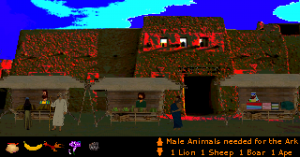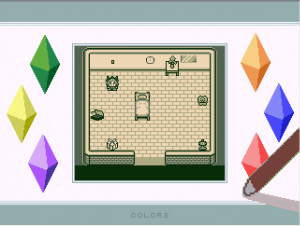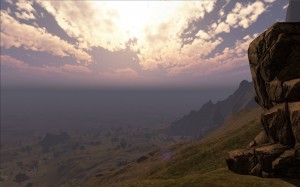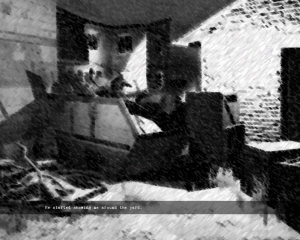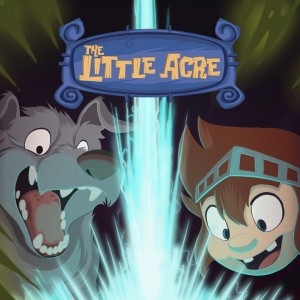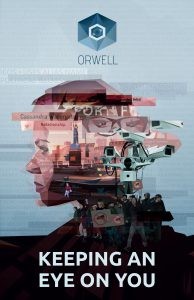Following Freeware: August 2017 releases page 2
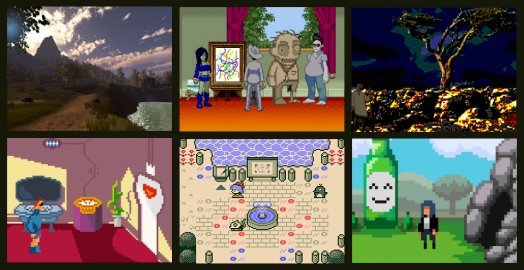
This month you can become an undead detective seeking a master thief, or a young girl trying to restore colour to a black and white world. You could also travel far back into the past as Noah seeking the last animals for his Ark, or into a far future where an intelligent apartment locks its owner inside. Alternatively, why not go for a walk in the park that may not turn out as relaxing as you might expect? All these await in this month's round-up of releases from the freeware scene.
Willem’s Winners
Zombie Society vs Nine Deaths Cat
In the second of three small Detective Margh game released before the big commercial Zombie Society adventure is completed early next year, we find the undead private investigator reading a note to his assistant Ghvnn. It's from the Nine Deaths Cat and is intended for Mr. Kashl, the art tycoon. Nine Deaths Cat is a notorious thief who has been stealing very valuable things for centuries and has never been caught. Margh is hired by Miss Slobber, a famous artist who makes paintings and statues, as for some reason it was she who got the note, not Mr. Kashl. The message says that Kashl is a bore and Nine Deaths Cat will steal the thing that he needs no more. And so, a new case is born.
 The artwork of Zombie Society vs Nine Deaths Cat will be very familiar to fans of the series. The game world is presented in third-person view and cartoony zombie characters walk around in a rather realistic world, drawn in a simple pixel art style but with enough detail to recognize everything. Apart from their office headquarters, Margh and Ghvnn visit a museum, an art studio, a police station and the house of someone introduced in an earlier game. The loud music that accompanies the action is the same as in the last game, and as before it's quite repetitive but can be switched off. The zombies' language is translated to English and displayed in speech balloons, so apart from the occasional zombie grunt you don't hear any voices. There are some good sound effects, though, such as the slamming of doors, the scratching of Margh's pen in his notebook, and the crash of objects falling.
The artwork of Zombie Society vs Nine Deaths Cat will be very familiar to fans of the series. The game world is presented in third-person view and cartoony zombie characters walk around in a rather realistic world, drawn in a simple pixel art style but with enough detail to recognize everything. Apart from their office headquarters, Margh and Ghvnn visit a museum, an art studio, a police station and the house of someone introduced in an earlier game. The loud music that accompanies the action is the same as in the last game, and as before it's quite repetitive but can be switched off. The zombies' language is translated to English and displayed in speech balloons, so apart from the occasional zombie grunt you don't hear any voices. There are some good sound effects, though, such as the slamming of doors, the scratching of Margh's pen in his notebook, and the crash of objects falling.
Gameplay is easy with the mouse-driven interface, the cursor changing to indicate interactive items and exits. A bar appears when the mouse is moved to the top of the screen, giving access to the inventory, Margh's notebook, a magnifying glass that shows all the hotspots in the current scene, and the game's menu from which you can save your progress. There is just one save slot, but the game is short and linear so that is enough. Few, if any, puzzles in this game are inventory-based. Instead you’ll have to persuade a guard to let you pass, as well as interview people, find evidence and make deductions from all the facts you gather. Of course Margh uses his handy deduction board once again: all clues are written down in his notebook, and by combining them you can draw conclusions about the questions raised during the investigation. The clues and deductions help you eventually decide what must have happened and predict what Nine Deaths Cat will do. Some clues are quite vague or cryptic this time, so it's a bit harder to find out who the criminal is and what they are after than in the previous games. In all, the game took me about 40 minutes to finish.
Zombie Society vs Nine Deaths Cat can be played online at Kongregate.
Noah's Quest
Noah has built his Ark and has gathered one male and one female of almost all species on the planet. He just needs to get a lion, a boar, an ape and a sheep, all male. But because there are only a few hours left before God pours down torrents of rain upon the Earth, Noah has to hurry.
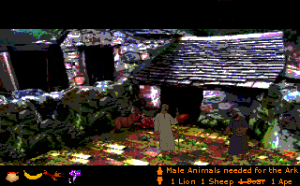 Noah's Quest, by slasher, is presented in third-person using crude pixelated paintings in which many colors are used. Dark clouds fill the sky in which the sun is very low, giving the landscape a suitably gloomy look. The characters are shown in a higher resolution than the backgrounds and are quite detailed. Noah has to find the animals he needs in their natural environments, so he visits a farm, the desert, a wood and a mountain to get them. There is also a market in the nearby village where he can buy things he needs for his quest. Imposing music, the particular tune depending on the location, plays in the background. There are a few sound effects, like the stamping of feet and howling of the wind, but they are not very realistic. In lieu of voice acting, all spoken text is shown in clear letters in a bar at the top of the screen.
Noah's Quest, by slasher, is presented in third-person using crude pixelated paintings in which many colors are used. Dark clouds fill the sky in which the sun is very low, giving the landscape a suitably gloomy look. The characters are shown in a higher resolution than the backgrounds and are quite detailed. Noah has to find the animals he needs in their natural environments, so he visits a farm, the desert, a wood and a mountain to get them. There is also a market in the nearby village where he can buy things he needs for his quest. Imposing music, the particular tune depending on the location, plays in the background. There are a few sound effects, like the stamping of feet and howling of the wind, but they are not very realistic. In lieu of voice acting, all spoken text is shown in clear letters in a bar at the top of the screen.
Noah is controlled with the mouse: right-clicking cycles the verbs look, grab, talk and walk, while left-clicking executes the command. The inventory is shown at the bottom of the screen, as well as a list of the animals Noah must find. Gathering the animals requires luring them from their lairs, so Noah needs to acquire things he can use to attract them. Once he has won an animal’s trust it will walk with Noah to the Ark without any problem. The puzzles are not hard but they are well made, logical and nicely integrated into the gameplay. However, it’s the interactions between Noah and the other characters that make the game worth playing. Noah is shown as a normal man in this game, who may have a strange delusion according to most of the people around them, but is still accepted as a friend or part of the village.
Noah's Quest can be downloaded from the AGS website.
Earthling Priorities
It's almost six in the morning when the apartment building is hit by lightning. This has strange consequences, one of them being that the door to our nameless protagonist's apartment now thinks that it's alive. Worse: it won't open for him. The door believes it's pointless for the protagonist to go to work, and is not shy in telling him its reasons for thinking so. But our protagonist has to go to work, so he’ll need to convince the door that it is wrong in order to open for him.
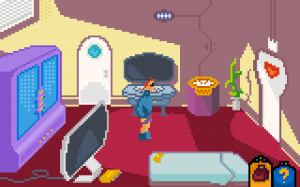 Earthling Priorities, by Konstantinos Dimopoulos, Daniele Giardini, Jim Spanos and Chris Christodoulou, is presented in third-person view in chunky pixel art. The game features only three locations: the bathroom and living room of the protagonist's apartment, and a square in front of a factory. There is no voice acting; all spoken text is displayed on the screen with a different color for each speaker. Sound effects, like the whooshing and creaking of doors opening, squeaking wheels and exploding fireworks are all reminiscent of the sounds that 8-bit computers of the 1980s made. The electronic background music is of high quality, however, and was made especially for the game.
Earthling Priorities, by Konstantinos Dimopoulos, Daniele Giardini, Jim Spanos and Chris Christodoulou, is presented in third-person view in chunky pixel art. The game features only three locations: the bathroom and living room of the protagonist's apartment, and a square in front of a factory. There is no voice acting; all spoken text is displayed on the screen with a different color for each speaker. Sound effects, like the whooshing and creaking of doors opening, squeaking wheels and exploding fireworks are all reminiscent of the sounds that 8-bit computers of the 1980s made. The electronic background music is of high quality, however, and was made especially for the game.
Right-clicking an object makes the protagonist share a description of it and left-clicking causes him to interact with it. Right-clicking the same object again often elicits another description, and the commentary provided can be quite funny. His observations clearly convey an eagerness to belong to the posh demographic that has the "right" things, often designed by famous people and very expensive. On the bottom right of the screen are two buttons: clicking the left one brings up the inventory, while the right one calls up the game's menu. Earthling Priorities is an odd parody on corporate culture and modern life, whose puzzles are not very hard but are logical and well-integrated. Although it is a short game (you can theoretically finish it in about 3 minutes), it took me about 20 minutes to complete when I first played it because there is quite a lot to see and the protagonist has something to say about nearly everything you click on. The ending is a bit strange but fitting for this game.
Earthling Priorities can be downloaded from the game’s website.
Steve’s Selections
COLORS: Lost Memories
A young girl wakes in a strange location, and this new land she finds herself in is entirely devoid of colour. Only she can gather together the crystals that will bring this world back to vibrant life. But many obstacles lay in her path, and not all the bizarre denizens of this place will prove helpful in this quest. If she is to return to the life she once knew, she will need to find her way to the deepest depths of this realm, and face the creature that awaits there.
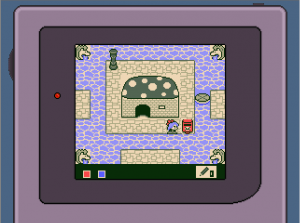 MemoriesofFear goes for a decidedly retro feel with COLORS: Lost Memories, with isometric graphics reminiscent of 1980s portable games. To accentuate this look, two of the viewscreen frames selectable from a device in the starting location are based on the original Nintendo Game & Watch and Game Boy handheld devices. Despite the low resolution of this retro style, there is sufficient detail to recognise most objects by sight. You start in a small room, but will soon find yourself scaling a tall mountain with an intricate cave system and swimming across a placid lake. The sound maintains the throwback feel, with a variety of 8-bit tunes accompanying the action, supplemented by basic sound effects like a hiss reminiscent of waves washing onto a shore.
MemoriesofFear goes for a decidedly retro feel with COLORS: Lost Memories, with isometric graphics reminiscent of 1980s portable games. To accentuate this look, two of the viewscreen frames selectable from a device in the starting location are based on the original Nintendo Game & Watch and Game Boy handheld devices. Despite the low resolution of this retro style, there is sufficient detail to recognise most objects by sight. You start in a small room, but will soon find yourself scaling a tall mountain with an intricate cave system and swimming across a placid lake. The sound maintains the throwback feel, with a variety of 8-bit tunes accompanying the action, supplemented by basic sound effects like a hiss reminiscent of waves washing onto a shore.
Control is handled with the cursor keys for movement and space to interact with whatever you are facing. The setting has a slightly dream-like quality to it, with talking animals and many different climates in a small area. At the start you only have a few screens to navigate, but the main game area is unlocked when you find the first crystal. Once you have one or more crystals, you can turn them on and off by interacting with the lecterns scattered throughout the map. This has various effects on the scenery, both good and bad. Red opens various doors, but it also makes areas that are on fire impassable. You are initially limited to having one colour activated at a time, though you can increase this later on. As well as opening and closing avenues of exploration, different colours alter how certain characters interact with you, so experimentation with different combinations is crucial to progress. It also forms the key to a couple of small mazes. The final challenge involves some mild arcade action, though this requires more brain-power than dexterity to beat. Your game can be saved by interacting with one of the post boxes scattered across the map.
COLORS: Lost Memories can be downloaded from the RPG Maker website.
A Walk in the Park
Life has been difficult for you lately, ever since it happened. But now you've been persuaded to get out by a friend who has organised a walk through scenic Yew Tree Park. He couldn't join you in person, but with a strong phone signal across the entire park, he is able to guide you remotely. As wend your way through the byways of the park and take in the varied scenery, you contemplate your recent past. Will this journey, and the jokes of your friend, lead you to a better place, or does a darker fate await you?
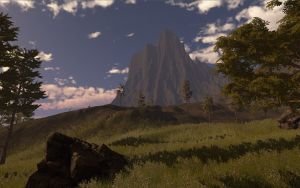 The Upturned Sheep's A Walk in the Park presents a beautiful locale, though it’s somewhat light on gameplay. The setting is a country park with a river running through it and a tall mountain dominating the skyline. Viewed in first-person, the landscape is rendered in highly realistic detail, from the leaves on the trees to the sandy gravel of the paths. The environment is backed by suitable sound effects, including bird song and the crunch of your footsteps. When you speak to your friend, his dialogue is fully voiced to a good standard, though the playable character's contributions are limited to single words or grunts. Between conversations a gentle guitar piece plays that nicely fits the natural setting.
The Upturned Sheep's A Walk in the Park presents a beautiful locale, though it’s somewhat light on gameplay. The setting is a country park with a river running through it and a tall mountain dominating the skyline. Viewed in first-person, the landscape is rendered in highly realistic detail, from the leaves on the trees to the sandy gravel of the paths. The environment is backed by suitable sound effects, including bird song and the crunch of your footsteps. When you speak to your friend, his dialogue is fully voiced to a good standard, though the playable character's contributions are limited to single words or grunts. Between conversations a gentle guitar piece plays that nicely fits the natural setting.
Movement is controlled through the WASD or cursor keys, with the mouse providing a full range of view in all directions. Whilst there is a clear path you are directed to follow, you are able to move about as freely as you would if you were actually there. Even with some landmarks to guide you, such as the mountain and an old church, it is easy to get lost, though the beautiful scenery may make that worthwhile. At various locations your friend contacts you, directing you to your next destination, making jokes and filling in more of a backstory that is quite dark. These contacts also serve as automatic save points, with a button for each location appearing in the main menu once you have reached it for the first time. There are a handful of interactive items to discover, usually involving a choice of two possible actions. These are not vital to completing the game, however, with navigation the only real challenge you have to overcome.
A Walk in the Park can be downloaded from Game Jolt.
Other releases
Not all games are created equal, and freeware games especially come in all shapes and sizes. Not to be overlooked, the following list might also be of interest, though these games may be significantly shorter or less polished, more experimental titles than those detailed above, some perhaps only borderline adventures to begin with.
Don't Worry, I'll Bring the Beer by Hobo – An offer to supply alcohol turns into a surreal journey in this extremely low-resolution adventure.
did by Goddialga – A young girl befriends a woman she sees in a mirror. Then one day, the woman sends her on a quest in the real world.
That’s it for this month. Think we’ve missed a gem or want to tell us about your own game? Then pop in to our Adventure forum and tell us about it!
Article written by Stephen Brown and Willem Tjerkstra.




